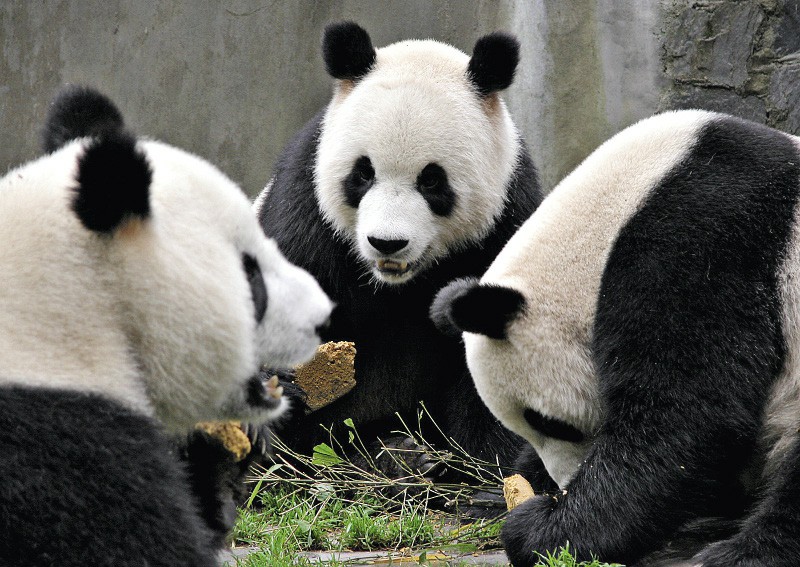Earlier this year, while taking photographs in western Sichuan Province in southwestern China, Cui Jianguo, a photography enthusiast from the region, came across a wild giant panda playing on a tree. He shot a video, which went viral when he posted it online, triggering a great deal of interest in the animal as well as renewed interest in the city where it was taken.
Ya’an is the place where the giant panda was first discovered by the outside world and named over a century ago. It is also the core area of the Giant Panda National Park as well as part of the Sichuan Giant Panda Sanctuaries, recognized by UNESCO as having outstanding universal value for its importance for the observation of the species. Giant pandas are a common sight in the city, with their habitats in eight counties and districts.

A giant panda party at the Ya’an Bifengxia Base of CCRCGP (China Conservation and Research Center for the Giant Panda) in Sichuan Province. Photo courtesy of Wang Yong
Discovery of a French Missionary
The stage was set for the outside world’s acquaintance with the giant panda in 1869, when Armand David, a French missionary Catholic priest and naturalist, arrived in Baoxing, the county where more than a century later, Cui came across the giant panda. Besides serving the local Catholic church in the countyside, the 36-year-old was also commissioned by the National Museum of Natural History in Paris to collect botanical, zoological and other specimens from China, of which the outside world had little knowledge at that time.
Over the following 12 years, David made three expeditions. The second one focused on Baoxing.
“Though not far from Chengdu, it is still cut off from the outside world owing to the desolate mountains and valleys, which are covered with virgin forest, allowing the local wildlife to survive,” he wrote in his diary.
On that expedition, his hired hunters brought him the body of a large animal with a white body and black limbs. He searched the records of existing animal species but could not find any such animal listed there. He referred to the animal at that time as “black and white bear” and later named it the panda, and the name has continued till today.
Panda Protection Timeline
Since the founding of the People’s Republic of China in 1949, the Chinese government has stepped up protection of the giant panda. Today, Ya’an has seven nature reserves mainly to conserve the species. In 1998, the city banned logging in its natural forests, and since then, the habitat of the giant panda has expanded. In 2003, the Bifengxia wild animal park in Ya’an became the world’s largest semi-wild giant panda base.
The local government and the Institute of Mountain Hazards and Environment in Chengdu proposed to the provincial government that a giant panda national park be established, covering Ya’an and neighboring areas, for protection of the species, popularization of science, and recreation.
At the end of 2005, the Sichuan Giant Panda Sanctuaries was declared a Natural World Heritage Site by UNESCO. David Shepherd, the chief evaluation expert, wrote: “Two Davids meet in Jiajin Mountain [a part of the sanctuaries] after 100 years. Our common goal is to protect the treasure of nature and of human beings, and create for the giant panda a good habitat to live in harmony with human beings.”
In 2006, the 30th World Heritage Conference of UNESCO unanimously decided to include the Sichuan Giant Panda Sanctuaries in the World Heritage list. This is the world’s largest wildlife conservation site, and the first of the kind in China to be included in the list. Ya’an accounts for 52 percent of the core land area of the sanctuaries.
In 2016, a pilot plan for the giant panda national park system was approved, extending from Sichuan to Shaanxi and Gansu provinces. The 27,000-square-kilometer Giant Panda National Park covers over 40 percent of Ya’an’s land area.
Back in the Wild
In 2014, the Liziping National Nature Reserve in Ya’an became China’s first base for giant pandas born or brought up in the sanctuaries to be trained to live in the wild. Of the 11 giant pandas released into the wild in China, nine were released in Liziping.
According to the fourth giant panda census in 2015, there are more than 30 giant pandas living in this area, and their number is increasing, with the arrival of new migrants. It is hoped that by releasing the pandas born in captivity into the local wild population, their genetic diversity will increase and their number will grow.
With the relocation of the giant pandas to Liziping, Yang Zhisong, a professor at the College of Life Sciences at China West Normal University (CWNU) in Sichuan, also migrated there. Yang, the first leader of the panda monitoring team during their release into the wild, moved his office from the campus to the mountains. “I spent more time working in the field at Liziping than teaching in the classroom,” he said.
To ensure that the pandas released in Liziang live undisturbed by human activities, the Yi, an ethnic group who were the original residents of the area, have been relocated.
“The real home of pandas is in the wild, and returning them to nature is the ultimate meaning of all efforts,” Yang said. “The pandas released into the wild are in good condition. “The work has achieved the expected goal,” he added.

Sichuan Giant Panda Sanctuaries are now a World Natural Heritage site. The picture shows experts from the World Heritage Committee inspecting the giant panda habitat in Ya’an.
A Success Story
The story of the protection of the giant panda in China would remain incomplete without mentioning Cui Xuezhen, a conservator who came to work in Ya’an in 1969 from Jiangsu Province in the east. He worked in Baoxing for more than three decades, helping rescue and save more than 50 critically ill wild pandas.
These include Basi, the female giant panda who when she died in 2017 at the age of 37, was the oldest panda in captivity. Panpan, the mascot of the 1990 Asian Games in Beijing, was modeled after her. “I have … only one thing to do in my life, that is to protect giant pandas,” Cui once said.
There are now more than 1,800 giant pandas in the wild in China. With their population growing, they are now no longer considered an “endangered” species but only “vulnerable.”
When it triggered some debate as to whether the move was justified, Cui said the International Union for Conservation of Nature, the global authority on endangered species, had changed the threat level of the giant panda from “endangered” to “vulnerable” much earlier – in 2016. Human activities such as deforestation, land reclamation, mineral resources development, and transportation and water conservancy projects had pushed pandas to the brink of extinction, but China has made remarkable efforts to save the giant panda, he said.
He also pointed out that the government has enacted the Wildlife Protection Law, Regulations on Nature Reserves and other laws and regulations. A number of national protection measures have been taken, including a ban on poaching, a giant panda habitat protection project, a network of giant panda nature reserves, and a project to return farmland to forests. The new classification of the giant pandas reflects the improvement in China’s ecology and the effectiveness of panda protection.